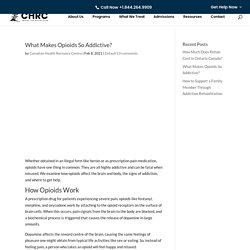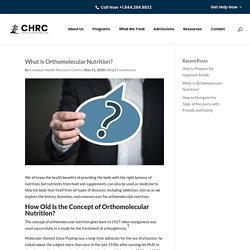

Canadian Health Recovery Centre
The Canadian Health Recovery Centre is a private addiction rehab treatment centre designed exclusively to care for men with substance abuse and dependence problems located in Peterborough, Ontario. Our comprehensive residential inpatient treatment approach is designed to address our client’s specific needs and provide the personal attention required to reach their recovery goals, in a beautiful setting.
What Makes Opioids So Addictive? Whether obtained in an illegal form like heroin or as prescription pain medication, opioids have one thing in common: They are all highly addictive and can be fatal when misused.

We examine how opioids affect the brain and body, the signs of addiction, and where to get help. How Opioids Work A prescription drug for patients experiencing severe pain, opioids like fentanyl, morphine, and oxycodone work by attaching to the opioid receptors on the surface of brain cells. When this occurs, pain signals from the brain to the body are blocked, and a biochemical process is triggered that causes the release of dopamine in large amounts. Dopamine affects the reward centre of the brain, causing the same feelings of pleasure one might obtain from typical life activities like sex or eating. Opioids also mimic endorphins, which are the body’s natural pain-relieving chemicals, but send far stronger signals for blocking pain than endorphins can. How and Why Opioids Are Addictive Dopamine Release. Poor Gut Health Could Be the Cause of Your Depression & Anxiety.
Terms like “gut-brain connection,” “good gut bacteria,” and “gut microbiome” have become household terms, and for good reason.

It’s been discovered that our gut health is not only largely responsible for our overall health, but that an unhealthy gut can have serious consequences in terms of our mental health. Is the Gut a Second Brain? It’s true that the gut contains trillions of bacteria, both good and bad, but the millions of neurons located in gut walls and an independent nervous system have led many to call it the second brain. However, those aren’t the only reasons the gut has been termed this; it was discovered that even when the vagus nerve, the body’s longest and primary neural conduit to the brain, was severed, the gut’s independent neural network continued to function. Relapse Triggers to Avoid When Recovering from Drug Addiction. Relapsing, or returning to misusing a substance following a period of sobriety, is common among those who struggle with addiction.

Certain people, places, memories, and thoughts can be the triggers for alcohol relapse, but in being able to understand and identify them, you can be in the best position to maintain your sobriety. How Relapse Occurs Although the act of relapsing occurs a single time, the process leading up to relapse occurs in three stages: emotional, mental, and physical. Emotional Relapse This first stage can begin to occur even if you’re in recovery at an inpatient drug treatment centre. Mental Relapse During the second stage of mental relapse, there is a constant battle between the side of you that wants to get and remain sober and the side that wants to start using again. Physical Relapse. What Is Orthomolecular Nutrition? We all know the health benefits of providing the body with the right balance of nutrition, but nutrients from food and supplements can also be used as medicine to help the body heal itself from all types of diseases, including addiction.

Join us as we explore the history, branches, and common uses for orthomolecular nutrition. How Old Is the Concept of Orthomolecular Nutrition? The concept of orthomolecular nutrition goes back to 1927 when manganese was used successfully in a study for the treatment of schizophrenia.1 Molecular chemist Linus Pauling was a long-time advocate for the use of vitamins; he talked about the subject more than once in the late 1930s after earning his Ph.D. in chemistry and being elected to the National Academy of Sciences in 1925 and 1933 respectively.2 He was the recipient of a Nobel Prize in Chemistry in 1954 and a Nobel Peace Prize in 1962. What Does “Orthomolecular Nutrition” Refer To? What Kinds of Nutrients Have Been Used in Orthomolecular Medicine? Vitamin C. How to Avoid Relapse Triggers During Thanksgiving. For many, Thanksgiving means enjoying special times with family over a good meal.

But for those who are about to attend their first sober Thanksgiving, worry, anxiety, and stress may overshadow the joy of this holiday. Implementing these tips for avoiding relapse triggers will help to keep you confident about and focused on your sobriety. Adopt a Realistic Point of View That Focuses on You We all have visions in our minds of what the perfect Thanksgiving should look like. However, recovery in substance abuse treatment centres teaches the vital importance of being honest with yourself and realistic about your expectations; having high expectations for a perfect holiday will only result in disappointment, which can trigger relapse.
Instead of visualizing how others will affect your Thanksgiving experience, focusing on the positivity of your sobriety will keep you centred and grounded regardless of what may be happening around you. Identify Your Triggers, Have a Plan Dealing With Cravings. Outpatient vs. Inpatient Program. Deciding to live your life free of alcohol or drugs is the first step toward recovery.

Next, you will have to decide which type of treatment is right for you. Both inpatient rehab and outpatient treatment can be effective at helping you achieve recovery; we compare both programs to help you understand the differences and make an informed decision about treatment. Outpatient Treatment Outpatient treatment allows you to revolve drug or alcohol addiction treatment around your work, school, and other life responsibilities while you live at home.
This option requires you to attend scheduled therapy sessions at a facility, for several hours per week.